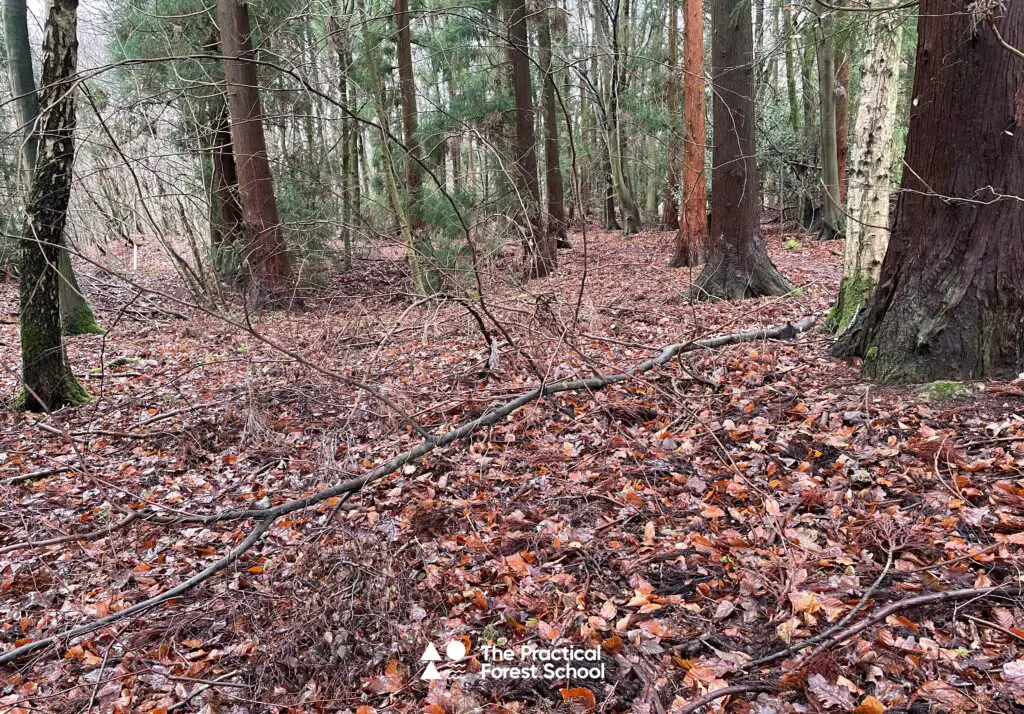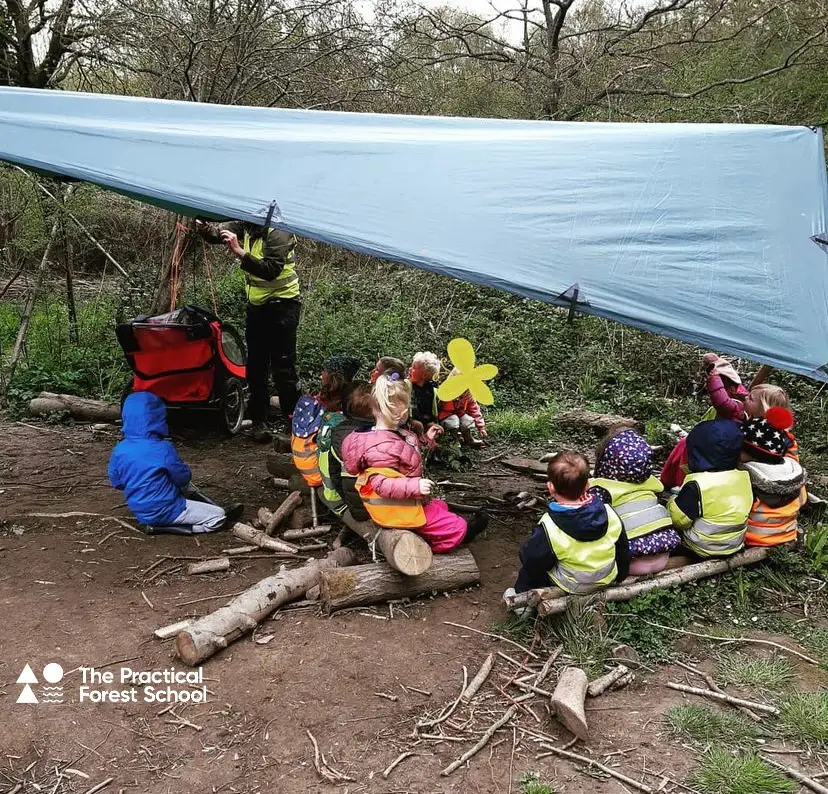Planning and Preparation at a Forest School Programme
This article contains affiliate links at no cost to you.
Are you taking the Level 3 Forest School Leader training? If so, you’ll need to create a portfolio that showcases your understanding and application of what you have learned. In this article, I’ll share a forest school portfolio example so you can see the kinds of things that are expected for the unit on planning and preparation.
One of the units in the training is the Forest School approach to planning and preparation. The exact name of your unit might be different, but it will cover the same or similar topics. I completed my Level 3 portfolio in 2018 and below I share a shortened and edited version of what I submitted.
This is not offered for you to copy – plagiarism is both not necessary and not supportive of your development as a Forest School Leader. Instead, it’s just to give you some starting points about what kinds of things could be included when you write your own.
The Planning and Preparation Unit
This unit of the forest school leader training has the following learning outcomes:
- Understand the development of forest school
- Be able to manage the ecological impact of a forest school programme
- Be able to develop the underpinning documents required for a forest school
- Be able to plan a forest school programme in line with the forest school ethos and principles.
Let’s look at each of those.
1. Understand the development of forest school
This is another part of your forest school leader training where there’s some more ‘academic’ stuff to cover. This section asks you to:
- Summarise the key factors that have influenced the development of forest school
- Identify local forest school networks
- Evaluate one piece of research on forest school (just one piece! It’s not that difficult, I promise)

Example from my Level 3 Portfolio:
The first recorded evidence of outdoor learning in the UK was published in May 1620 with an account of 13 and 14 year old apprentices of the London Society of Apothecaries being taken into the country on ‘herbalising’ tours to collect and study the various plants and herbs (called ‘simples’) used for medicinal purposes.
In modern times, outdoor learning has become widespread, for instance as seen in the Scouting movement. However, the outdoor learning that we define as Forest School is a relatively recent phenomenon. ‘Forest School’ in the UK can be traced back to 1993 when a group of Bridgewater nursery nurses visited Danish pre-schools and brought back the Scandinavian idea of Frulitsliv, open air culture, a pedagogue promoting outdoor child centred learning.
From there Forest School took off with various colleges and local authorities providing funding and training. Between 2000 and 2011 the growth continued with the involvement of the Forestry Commission and the Institute of Outdoor Learning. In 2011 the Forest School Association was created to develop these ideas and provide the Forest School Principles’ and Criteria. The FSA continues to be the main professional body for practitioners in the UK today.
As you can see, you don’t have to write a huge essay on the history of forest school. I went on to outline local networks through my local FSA branch.
For the research evaluation, I wrote about Green Mind Theory, by Pretty, Rogerson and Barton from the University of Essex. This article as provided along with the other learning materials on my course, so if you are just getting into the idea of what to put in your forest school Level 3 portfolio, do not worry – your trainers will be able to suggest materials to evaluate for this section and may (like mine) even provide them for you.
Of course, you could find your own research to evaluate if there is a particular topic you want to investigate, but don’t be put off by this part of the course.
2. Be able to manage the ecological impact of a forest school programme
Next, we have the section on the environmental impact. You’ll be assessed on your ability to comment on the ecological impact of forest school sessions on your own site and also your ability to create a 3-year plan for your site.
Example from my forest school portfolio:
Ecologically speaking the site is small and not well used which means there is a constant battle to prevent it from being over grown. From a safety point of view, I need to keep various lines of sight clear so that I can easily observe the children without having to place too many restrictions on where they can play. I have prioritised keeping the pathways clear and also, when possible, I try to ensure there are big enough clearings for the children to play games.
When harvesting hazel for crafts such as making bows and arrows, I have explained that we can only take a few stems from each bush, and we must not harvest too much as to only have a limited amount of hazel on site.
I went on to talk about the size of the group, the impact on the site and briefly mentioned the infrastructure on site too, even though that is not strictly speaking ecological e.g. the shelter and gate.

Your 3-year plan
Next, you’ll need to create a 3-year plan for sustainable use of your site. I was able to use a template from MyForest for Education from the Sylva Foundation as the basis of my management plan. It might seem daunting, but it was actually pretty easy.
You might need some input from the caretaker or other site manager, but you should be able to create a sample plan on your own. Some things you might want to include could be:
- Removing dead branches
- Clearing rubbish from waterways
- Maintaining structures and footpaths
- Monitoring for damage
- Containing the spread of nettles and brambles
Or other things relevant to your setting. Include a map or aerial view and some photos. I also included a narrative section for the environment assessment and management plan as well as the action plan list of activities to do per year (many of which were relevant for every year of the 3-year plan).
3. Be able to develop the underpinning documents required for a forest school
This is the part where you create a handbook for your forest school.
It should contain:
- Comprehensive forest school risk assessments
- Relevant policies and procedures
- Risk benefit analysis
- Communication strategy
And anything else essential for running the programme.
Example Forest School Handbook
My after school club handbook includes the following sections:
- Emergency procedures
- Site information
- Communication (with parents, school etc, and including contact details)
- First aid
- Provisions for poor weather
- Toileting
- Fire safety
- Hand tool usage
- Clothing (including clothing list of what to wear for forest school sessions)
- Staff list and insurance details
- Risk assessments
4. Be able to plan a forest school programme in line with the forest school ethos and principles
This section has the following assessment criteria:
- Explain the role of the forest school programme leader
- Explain the rational of your own forest school programme showing links to your group’s learning and development needs
- Plan the first of your sessions
Example from my Forest School Level 3 Portfolio:
I run an after school club and my main aim will always be to use the forest school principles to ensure the kids in my care are having fun and want to keep returning. My role is to teach them new skills and knowledge about the woodland environment, obviously making sure this is done in a safe and professional manner.
I went on to outline some other roles of the forest school leader before addressing the rationale for why I do forest school the way I do and providing examples of how that links to my group’s needs. You’ll need to draw on your own reflective practice and examples to put in this section.
If you have already delivered your sessions, you can include all the session plans in the content for the unit on delivery, and simply reference one (or all of them here). There’s no need to write it all out again.
Creating your portfolio
Your training provider will probably provide guidance notes – I got helpful guidance notes from the Sussex Wildlife Trust which were useful in identifying the major points and topics to include in my responses. The notes also sometimes provided a word length, which was helpful.
Your trainer will also have advice, and my group created a WhatsApp group so there was a lot of chat on there as we went through our training.
Good luck with your Forest School Leader training!
Read next:
- Forest School Programmes and the Woodland Environment
- Practical Skills for a Forest School Programme
- Learning and Development at a Forest School Programme
- Delivery of a Forest School Programme

About the author: Jon Borley
Jon qualified as a Level 3 Forest School Leader with the Sussex Wildlife Trust. He works independently as a practitioner running forest school clubs and also within schools both in a forest school capacity and as an outdoor learning teaching assistant, working with preschoolers to secondary-aged children. He has previously led sessions for adults as part of professional development events for the Sussex FSA, and is a member of MIAS.